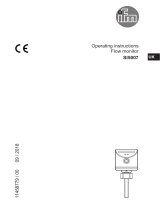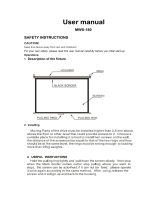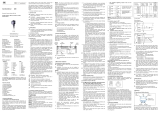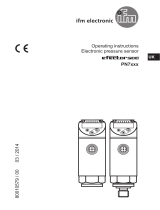
Operating instructions
Electronic pressure sensor
PI27xx
UK
80260757 / 00 11 / 2022

2
Contents
1 Preliminary note ...................................................................................................4
1.1 Symbols used ................................................................................................4
2 Safety instructions ...............................................................................................4
3 Functions and features ........................................................................................5
3.1 Applications ...................................................................................................5
4 Function ...............................................................................................................6
4.1 Operating modes ...........................................................................................6
4.1.1 2-wire operation .................................................................................... 6
4.1.2 3-wire operation .................................................................................... 6
4.2 Switching function (only for 3-wire operation) ................................................7
4.3 Analogue function ..........................................................................................7
4.4 Customer-specific calibration ........................................................................8
5 Installation..........................................................................................................10
5.1 Units with G1 / Aseptoflex Vario process connection...................................10
5.2 Use in hygienic areas to 3-A ........................................................................ 12
5.3 Use in hygienic areas to EHEDG ................................................................12
5.4 Ventilation diaphragm ..................................................................................13
5.4.1 Function ventilation diaphragm ...........................................................13
5.4.2 Orientation ..........................................................................................14
5.5 Filter cover ...................................................................................................14
6 Electrical connection ..........................................................................................16
6.1 Connection for 2-wire operation ..................................................................16
6.2 Connection for 3-wire operation ..................................................................16
7 Operating and display elements ........................................................................17
8 Menu ..................................................................................................................18
8.1 Menu structure: main menu .........................................................................18
8.2 Explanation of the main menu .....................................................................19
8.3 Menu structure: level 2 (extended functions) ...............................................20
8.4 Explanation of menu level 2 ........................................................................21
8.5 Menu structure: level 3 (simulation) .............................................................22
8.6 Explanation of menu level 3 ........................................................................23
9 Parameter setting ..............................................................................................24
9.1 Parameter setting in general .......................................................................24
9.2 Configure display (optional) ......................................................................... 26

3
UK
9.3 Set output signals ........................................................................................26
9.3.1 Set output functions ............................................................................ 26
9.3.2 Set switching limits .............................................................................27
9.3.3 Scale analogue value for OUT2 .........................................................27
9.4 User settings (optional) ................................................................................28
9.4.1 Carry out zero point calibration ..........................................................28
9.4.2 Set output status in fault condition ......................................................28
9.4.3 Set delay time for the switching outputs .............................................29
9.4.4 Set output logic for the switching outputs ...........................................29
9.4.5 Set damping for the switching signal ..................................................29
9.4.6 Set damping for the analogue signal ..................................................29
9.4.7 Calibrate curve of measured values ...................................................29
9.5 Service functions .........................................................................................30
9.5.1 Read min/max values for the system pressure ..................................30
9.5.2 Reset all parameters to factory setting ...............................................30
9.6 Simulation function ......................................................................................30
9.6.1 Open menu level 3 (simulation) .......................................................... 30
9.6.2 Set simulation value ...........................................................................31
9.6.3 Set time for simulation ........................................................................31
9.6.4 Start simulation ................................................................................... 31
10 Operation .........................................................................................................32
10.1 Read set parameters .................................................................................32
10.2 Change the display in the Run mode .......................................................32
10.3 Self-diagnostics / error displays .................................................................33
10.4 Setting ranges ...........................................................................................35
11 Factory setting .................................................................................................37

4
1 Preliminary note
1.1 Symbols used
►Instruction
> Reaction, result
[…] Designation of keys, buttons or indications
→Cross-reference
Important note
Non-compliance may result in malfunction or interference.
Information
Supplementary note.
2 Safety instructions
• The device described is a subcomponent for integration into a system.
- The manufacturer is responsible for the safety of the system.
- The system manufacturer undertakes to perform a risk assessment and to
create a documentation in accordance with legal and normative requirements
to be provided to the operator and user of the system. This documentation
must contain all necessary information and safety instructions for the operator,
the user and, if applicable, for any service personnel authorised by the
manufacturer of the system.
• Read this document before setting up the product and keep it during the entire
service life.
• The product must be suitable for the corresponding applications and
environmental conditions without any restrictions.
• Only use the product for its intended purpose (→ Functions and features).
• Only use the product for permissible media (→ Technical data).
• If the operating instructions or the technical data are not adhered to, personal
injury and/or damage to property may occur.
• The manufacturer assumes no liability or warranty for any consequences
caused by tampering with the product or incorrect use by the operator.
• Installation, electrical connection, set-up, operation and maintenance of the
product must be carried out by qualified personnel authorised by the machine
operator.
• Protect units and cables against damage.

5
UK
3 Functions and features
The unit measures and monitors the system pressure in a plant.
3.1 Applications
Type of pressure: relative pressure
Order no. Measuring range Permissible
overload pressure Bursting pressure
bar psi bar psi bar psi
PI2793 -1...25 -14.4...362.7 100 1450 350 5075
PI2714 -1...16 -14.6...232 75 1085 250 3625
PI2794 -1...10 -14.5...145 50 725 150 2175
PI2715 -1...6 -14.5...87 30 435 100 1450
PI2795 -1...4 -14.5...58 30 435 100 1450
PI2796 -0.124...2.5 -1.8...36.27 20 290 50 725
PI2797 -0.05...1 -0.73...14.5 10 145 30 435
PI2799 -1...1 -14.5...14.5 10 145 30 435
mbar psi mbar psi mbar psi
PI2717 -100...1600 -1.46...23.2 15000 215 40000 580
mbar inH2O bar inH2O bar inH2O
PI2798 -12.4...250 -5.0..100.4 6 2400 30 12044
PI2789 -5...100 -2.00...40.16 4 1606 30 12044
Avoid static and dynamic overpressure exceeding the specified overload
pressure by taking appropriate measures.
The indicated bursting pressure must not be exceeded.
Even if the bursting pressure is exceeded only for a short time, the unit
may be destroyed. ATTENTION: Risk of injury!
Not suitable for use where the criteria for paragraph E1.2/63-03 of the 3-A
standard 63-03 have to be met.
The units are vacuum resistant.

6
4 Function
• The unit displays the current system pressure.
• It generates output signals according to the operating mode and the parameter
setting.
• It moreover provides the process data via IO-Link.
• The unit is laid out for fully bidirectional communication. So the following
options are possible:
- Remote display: reading and displaying the current system pressure.
- Remote parameter setting: reading and changing the current parameter
setting.
- Using the FDT service program ifm Container, the current parameter settings
can be stored and transferred to other units of the same type.
The program library of the available DTM objects can be found at www.ifm.
com.
Device-specific parameter lists for IO-Link parameter setting are available at:
www.ifm.com
4.1 Operating modes
The operating mode is defined by the wiring (→ 6 Electrical connection) and
automatically recognised by the unit.
4.1.1 2-wire operation
OUT2 (pin 2) Analogue signal proportional to pressure 4…20 mA or 20...4 mA
4.1.2 3-wire operation
OUT1 (pin 4) • Switching signal for system pressure limit
• Communication via IO-Link
OUT2 (pin 2)
3 options:
• Switching signal for system pressure limit
• Analogue signal proportional to pressure 4...20 mA
• Analogue signal proportional to pressure 20...4 mA

7
UK
4.2 Switching function (only for 3-wire operation)
OUTx changes its switching status if it is above or below the set switching limits
(SPx, rPx). The following switching functions can be selected:
• Hysteresis function / normally open: [OUx] = [Hno] (→ Fig. 1).
• Hysteresis function / normally closed: [OUx] = [Hnc] (→ Fig. 1).
First the set point (SPx) is set, then the reset point (rPx) with the requested
difference.
• Window function / normally open: [OUx] = [Fno] (→ Fig. 2).
• Window function / normally closed: [OUx] = [Fnc] (→ Fig. 2).
The width of the window can be set by means of the difference between SPx
and rPx. SPx = upper value, rPx = lower value.
1 2
P = system pressure; HY = hysteresis; FE = window
4.3 Analogue function
The analogue output can be configured.
• [OU2] defines whether the set measuring range is provided as 4...20 mA
([OU2] = [I]) or as 20...4 mA ([OU2] = [InEG]).
Scaling can be set by means of the teach process or by entering a value for the
parameters ASP and AEP.
• Teaching the analogue start point [tASP] or setting the parameter [ASP] defines
at which measured value the output signal is 4 mA (20 mA with [InEG]).
• Teaching the analogue end point [tAEP] or setting the parameter [AEP] defines
at which measured value the output signal is 20 mA (4 mA with [InEG]).
Minimum distance between [ASP] and [AEP] = 25 % of the final value of the
measuring range (turn-down 1:4); for PI2799: 25 % of the measuring span.

8
Factory setting Measuring range scaled
P = system pressure , MAW = initial value of the measuring range, MEW = final value of
the measuring range
1
: [OU2] = [I];
2
: [OU2] = [InEG]
In the set measuring range the output signal is between 4 and 20 mA ([OU2] = [I])
or between 20 and 4 mA ([OU2] = [InEG]).
It is also indicated:
• System pressure above the measuring range:
- Output signal > 20 mA at [OU2] = [I].
- Output signal 4 to 3.8 mA if [OU2] = [InEG].
• System pressure below the measuring range:
- Output signal 4 to 3.8 mA if [OU2] = [I].
- Output signal 20 mA at [OU2] = [InEG].
4.4 Customer-specific calibration
The customer-specific calibration changes the curve of measured values
compared to the real measured values (shifting / change of the gradient; → 9.4.6
[CAL]).
• Two calibration points can be defined (CP1, CP2). The two points are
independent of each other.
• The two calibration points must be within the scaled measuring range (→ 4.3
Pressure monitoring / analogue function).
• The zero point calibration [COF] influences the calibration of the curve of
measured values. Recommendation: Set [COF] to 0 (→ 9.4.1 [COF]), then
calibrate the curve of measured values.

9
UK
After a change the calibration can be reset to factory setting (→ 9.5.2 [rES]).
• P = measured pressure;
P‘ = modified measured value
• CP1 = calibration point 1
CP1‘ = modified measured value for
CP1
• CP2 = calibration point 2;
• 1 = curve of measured values with
factory setting
• 2 = curve of measured values after
calibration
• P = measured pressure;
P‘ = modified measured value
• CP1 = calibration point 1
CP2 = calibration point 2
CP2‘ = modified measured value for
CP2
• 1 = curve of measured values with
factory setting
• 2 = curve of measured values after
calibration
• P = measured pressure
P‘ = modified measured value
• CP1 = calibration point 1
CP1‘ = modified measured value for
CP1
• CP2 = calibration point 2
CP2‘ = modified measured value for
CP2
• 1 = curve of measured values with
factory setting
• 2 = curve of measured values after
calibration

10
5 Installation
►Before installing and removing the unit make sure that no pressure is
applied to the system and there is no medium in the pipe.
Please note
when the system pressure is displayed in % of the span: "0" does not
mean that no pressure is applied to the system!
►Note dangers related to external system / medium temperatures.
5.1 Units with G1 / Aseptoflex Vario process connection
►Insert the unit with process adapter into the process connection and tighten
using a spanner.
Information about available adapters at www.ifm.com.
►Observe the instructions of the adapter.
►Use a lubricating paste which is suitable and approved for the
application.
►Tighten firmly. Recommended tightening torque: 35 Nm.
Depends on the sealing type, the pressure load and the lubrication!
The unit can be fixed to different process connections.
Options are as follows:
1Installation using an adapter with sealing ring (hygiene-compliant)
Order no. E332xx / E333xx.
►To meet the hygiene regulations use a process adapter with leakage
port.
The adapters are supplied with EPDM O-ring (order no. E30054).
More sealing rings are available as accessories:
• FKM O-ring (order no. E30123)
• PEEK sealing ring (order no. E30124). The PEEK sealing ring is long-
term stable and maintenance-free.
►When you replace the PEEK sealing ring or change from a PEEK sealing
ring to an O-ring, the process adapter also needs to be replaced with a
new equivalent adapter.

11
UK
2Installation using a welding adapter with sealing ring (hygiene-
compliant)
►To meet the hygiene regulations use a process adapter with leakage
port.
►Make sure that the process adapter does not warp during welding. Use
welding mandrel E30452.
►The sealing edge must not be damaged by subsequent surface
treatment
(→ instructions in operating instructions of the adapter).
The adapter is supplied with EPDM O-ring (order no. E30054).
Another sealing ring is available as accessory:
• FKM O-ring (order no. E30123).
3Installation using a process adapter with metal-to-metal seal
Order no. E337xx / E338xx
A long-term stable and maintenance-free fitting without bug traps in
the metal-to-metal seal is only valid for once-only mounting.
►If the sealing has to be installed several times, use a new adapter.
4Installation to G 1 flange / G 1 bush
The process is sealed with the sealing ring at the back of the process
connection.
►The sealing area at the flange / bush must be flush with the tapped hole
and have a surface characteristic of min. Rz = 6.3.

12
5.2 Use in hygienic areas to 3-A
The following applies to units with 3-A
certification:
►Only use adapters with 3-A
certification for the process
connection.
►Do not install the unit at the lowest
point of the pipe or tank
(→ position 5) in order that the
medium can run off the area of the
measuring element.
5.3 Use in hygienic areas to EHEDG
In case welded adapters are used, the food contact surface must be
smooth (surface roughness Ra < 0.8 µm) and the welding has to be done
according to EHEDG Guideline 9 and35.
The sensor is suited for CIP (cleaning in process) when installed correctly.
►Observe the application limits (temperature and material resistance)
according to the data sheet.
►Make sure that the sensor is integrated into the system according to EHEDG:
►Use self-draining installation.
►Only use process adapters permitted according to EHEDG with special seals
required by the EHEDG position paper.
The gasket of the system interface must not be in contact with the
sealing point of the sensor.
►In case of structures in a tank, the installation must be flush mount. If not
possible then direct water jet cleaning and cleaning of dead spaces must be
possible.
►Leakage ports must be clearly visible and must be installed facing downwards
for vertical pipes.

13
UK
1
D
L
►To avoid dead space adhere to the
dimensions:
L < (D).
1: Leakage port
5.4 Ventilation diaphragm
5.4.1 Function ventilation diaphragm
The ventilation diaphragm enables the relative pressure measurement since
barometric and temperature-dependent pressure fluctuations between the
measuring cell and the environment are compensated for.
The ventilation diaphragm is protected against damage by a screwed filter cover
with circumferential ports.
For a correct functioning of the diaphragm please take the following into
account:
►Remove soiling and cleaning agents immediately using plenty of lime-
deficient splash water.
If the sensor is in a cooling stage:
► Avoid contact of the diaphragm with liquids:
> Avoids negative pressure in the measuring system resulting in
a slightly falsified measured value and additional strain on the
diaphragm.

14
5.4.2 Orientation
When the sensor is mounted in a vertical position, the condensate escapes
through the ports in the filter cover due to gravity.
When the sensor is mounted in a horizontal position and the display is
facing upwards or downwards, the escape of the condensate through the
filter cover is reduced since it is at the highest or lowest position
(→ Fig. Orientation of the filter cover).
►Recommendation:
Use accessories (→ 5.5, 4)to bring the ventilation diaphragm into a
vertical position = ideal orientation (1).
> The condensate can escape faster due to gravity.
3
1
2
►Ideal orientation (1):
Filter cover in horizontal position.
The ventilation diaphragm (2)
in the filter cover is in a vertical
position.
►Maximum inclination: 30° (3)
Fig.: Orientation lter cover
5.5 Filter cover
Replace filter cover:
1Exchange the filter cover incl. GORE diaphragm (E30142).
2Replace the filter cover with a closed version (E30148) (*)
Improve the protection of the filter cover:
3Replace the filter cover with a version with a tube fitting and a vent tube that ends in a
protected and dry area (E30139).
4Set of accessories (E30467) with integrated replacement diaphragm (GORE), for high
degree of soiling and / or high climate pollution.
Function: (→ Installation instructions E30467)

15
UK
►Avoid soiling and moisture during the replacement
►Clean the thread carefully and without residues
►Do not damage the adhesive area of the sensor
►Observe the orientation of the filter cover
(→ Installation instructions E30139 / 30467)
123
4
(*) When using the closed filter cover, there is no pressure compensation
of the measuring cell any more. This results in measurement deviations
caused by:
• fluctuations of the atmospheric pressure
• pressure fluctuations inside the unit in case of temperature changes
(Δ 10 K ≤ 30 mbar).

16
6 Electrical connection
The unit must be connected by a qualified electrician.
The national and international regulations for the installation of electrical
equipment must be adhered to.
Voltage supply according to EN 50178, SELV, PELV.
►Disconnect power.
►Connect the unit as follows:
6.1 Connection for 2-wire operation
Core colours
Original Scale Drawing (MTD)
EPS Source
Frame Size: 15 mm x 15 mm
PIN_0180
2 1
2 1
L+
BN1
WH2 OUT
BN brown
WH white
OUT: Analogue output 4...20 mA
Colours to DIN EN 60947-5-2
6.2 Connection for 3-wire operation
Core colours
43
2 1 BN
WH
BK
BU
4
1
3
2OUT2
L+
L
OUT1
BK black
BN brown
BU blue
WH white
OUT1: Switching output or IO-Link
OUT2: Switching output or analogue output
Colours to DIN EN 60947-5-2
Wiring example
2 x pnp 2 x npn
L
L+
3
4
2
1
BU
BK
WH
BN
2: OUT2
4: OUT1 L
L+
3
4
2
1
BU
BK
WH
BN
2: OUT2
4: OUT1

17
UK
Wiring example
1 x pnp / 1 x analogue 1 x npn / 1 x analogue
L
L+
3
4
2
1
BU
BK
WH
BN
2: OUT2
4: OUT1 L
L+
3
4
2
1
BU
BK
WH
BN
2: OUT2
4: OUT1
If analogue signal current (I) is selected in the menu under OU2 and the
output is not connected (resistance = infinite), the error message W532 is
displayed in intervals. The measuring result remains unaffected.
►Alternatively: Switch OU2 to switching output.
7 Operating and display elements
10
9
11
Mode/Enter Set
1 2 3 4 5 6 78
1 to 8: Indicator LEDs
- LED 1 to LED 5 = system pressure in the specified unit of measurement.
- LED 6 = system pressure in % of the set scaling of the analogue output (range ASP to
AEP) if [OU2] is configured as analogue output.
System pressure in % of the final value of the measuring range if [OU2] is configured as
switching output.
- LED 7 = switching status OUT2 (on if output 2 is switched).
- LED 8 = switching status OUT1 (on if output 1 is switched).
9: Alphanumeric display, 4 digits
- Display of the current system pressure.
- Indication of the parameters and parameter values.

18
10: Set button
- Setting of the parameter values (scrolling by holding pressed, incrementally by pressing
once).
11: Mode/Enter button
- Selection of the parameters and acknowledgement of the parameter values.
8 Menu
8.1 Menu structure: main menu
RUN
S
M
M
S
M
M
S
M
M
S
M
S
M
S
M
M
1
M
M
S
M
M
S
M
M
M
S
M
M
S
M
M
S
M
1: Change to menu level 2 (extended functions)
Menu items highlighted in grey ( SP1 ) are not active in 2-wire operation

19
UK
8.2 Explanation of the main menu
SP1/rP1* Upper / lower limit for system pressure at which OUT1 switches.
OU1* Output function for OUT1:
• Switching signal for the pressure limits: hysteresis function [H ..] or window
function [F ..], either normally open [. no] or normally closed [. nc].
OU2 Output function for OUT2:
• Switching signal for the pressure limits: hysteresis function [H ..] or window
function [F ..], either normally open [. no] or normally closed [. nc] (only
available for 3-wire operation).
• Analogue signal for the current system pressure: 4...20 mA [I], 20...4 mA
[InEG].
tCOF Teach zero-point calibration.
tASP Teach analogue start point for system pressure: set measured value at which
4 mA is provided (20 mA if [OU2] = [InEG]).
tAEP Teach analogue end point for system pressure: set measured value at which
20 mA is provided (4 mA if [OU2] = [InEG]).
SP2/rP2* Upper / lower limit for system pressure at which OUT2 switches.
EF Extended functions / opening of menu level 2.
* menu items not active in 2-wire operation

20
8.3 Menu structure: level 2 (extended functions)
M
M
S
M
M
S
M
M
S
M
M
S
M
M
S
M
S
M
M
S
M
M
S
M
M
S
1
1
M
M
M
S
M
M
S
M
S
M
S
M
S
M
S
M
M
M
M
M
M
S
M
M
S
M
M
S
M
M
M
S
M
S
M
S
2
S
M
1: Change to the main menu, 2: Change to menu level 3 (simulation).
Menu items highlighted in grey ( ASP ) are not active in 2-wire operation
Page is loading ...
Page is loading ...
Page is loading ...
Page is loading ...
Page is loading ...
Page is loading ...
Page is loading ...
Page is loading ...
Page is loading ...
Page is loading ...
Page is loading ...
Page is loading ...
Page is loading ...
Page is loading ...
Page is loading ...
Page is loading ...
Page is loading ...
-
 1
1
-
 2
2
-
 3
3
-
 4
4
-
 5
5
-
 6
6
-
 7
7
-
 8
8
-
 9
9
-
 10
10
-
 11
11
-
 12
12
-
 13
13
-
 14
14
-
 15
15
-
 16
16
-
 17
17
-
 18
18
-
 19
19
-
 20
20
-
 21
21
-
 22
22
-
 23
23
-
 24
24
-
 25
25
-
 26
26
-
 27
27
-
 28
28
-
 29
29
-
 30
30
-
 31
31
-
 32
32
-
 33
33
-
 34
34
-
 35
35
-
 36
36
-
 37
37
IFM PI2798 Operating instructions
- Category
- Measuring, testing & control
- Type
- Operating instructions
Ask a question and I''ll find the answer in the document
Finding information in a document is now easier with AI
Related papers
-
IFM PI2799 Operating instructions
-
IFM PN028A Operating instructions
-
IFM PI2309 Operating instructions
-
IFM PI1708 Operating instructions
-
IFM TM4911 Operating instructions
-
 IFM Electronic SI5007 Operating instructions
IFM Electronic SI5007 Operating instructions
-
IFM PIU707 Operating instructions
-
IFM PIU809 Operating instructions
-
IFM LMT01A Operating instructions
-
IFM LMT01A Operating instructions
Other documents
-
 techtop MWS-180 User manual
techtop MWS-180 User manual
-
Rosemount 326P Pressure Transmitter Quick start guide
-
Rosemount 326L Level Transmitter Quick start guide
-
Atos GS470 Owner's manual
-
Autonics FM6M-1P4 (01) Measure Counter User manual
-
Rosemount 327T Temperature Transmitter Quick start guide
-
 IFM Electronic TW2011 Operating Instructions Manual
IFM Electronic TW2011 Operating Instructions Manual
-
 Simex DS 200 Owner's manual
Simex DS 200 Owner's manual
-
 IFM Electronic PN7693 Operating Instructions Manual
IFM Electronic PN7693 Operating Instructions Manual
-
SICK LFP Inox Operating Instructions Manual









































